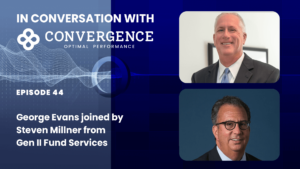No longer just an elusive new trend to watch, crypto and other digital assets are now finding their way into portfolios everywhere, with institutional inventors like hedge funds taking it considerably more seriously than before. More and more asset managers are taking a chance on the likes of Bitcoin and Ethereum, with many seeing considerable success as they deliver substantial returns to clients, who are showing an increased appetite for diversified portfolios that boast digital assets.
We explore the state of crypto investment trends with One River Asset Management president of One River Digital, Sebastian Bea, who discusses One River’s own success with Bitcoin and Ethereum so far, as well as what’s in store for crypto in the near future.
This blog’s insights are based on Episode 17 of our In Conversation with Convergence podcast, hosted by Convergence Co-Founder and President, George Evans. In this episode, George is joined by guest speakers Sebastian Bea from One River Digital and Convergence’s own Adam Safi, who discuss crypto investment trends currently being experienced in the asset management industry, and what influence crypto will have on alternative assets portfolios in the future. Listen via the Convergence website or scroll down to continue reading the blog.
One River Digital’s involvement in crypto so far
Off the back of the conjoining of monetary and fiscal policy in 2020 and the risk of inflation being higher than what may have been anticipated, One River set out to deliver unique diversification opportunities by making its first large digital allocation to crypto in November 2020. Considering how robust the previous cycle of crypto investment was, the initial $600 million allocation, mostly into Bitcoin and some into Ethereum, saw the asset management firm crystallize over a billion dollars of gains to return to their clients.
While 2020 was a notably perilous year for firms and the industry overall, One River’s long-haul funds and trend funds, like their crypto investments, made money, and their alpha products remained durable, allowing the firm to deliver risk mitigation in times of uncertainty. Building on this momentum, the firm started collaborating with other investment firms and getting involved in the crypto community at large, sponsoring a meetup event known as CryptoMondays – a regular get-together for a decentralized global community of people passionate about blockchain and cryptocurrency. now.
As the industry environment became increasingly decentralized, the adoption of new technology has been vital to the seamless transition to virtual. This has enabled firms to meet the important requirement of data centralization and aggregation and using centralized data formats so that employees can continue to access the necessary information they would typically only get at the office. This ease of access to shared data systems has been key to uninterrupted collaboration and business continuity.
Crypto is more than a fad
Once investment fad bubbles “pop” they tend to not come back. But when one considers the history of Bitcoin, it’s had a number of cycles and keeps coming back with new highs each cycle, despite questionable previous cycles. The growing number of Bitcoin wallets each cycle also shows the crypto coin’s growing popularity each cycle, suggesting that this asset class is certainly here to stay.
Although traditional finance investors remain focused on the uncertain regulation, price volatility and lack of identifiable cash flow that surrounds crypto investments, the persistent growth and increasing depth of the Bitcoin network – and therefore blockchain networks at large – is what piques decentralized finance investors’ interests.
One River’s advice to investors considering this asset class is to consider the resilience of these crypto coins from cycle to cycle and be curious. As FinTech continues to evolve, the money-moving systems we’ve become accustomed to are becoming archaic, and it’s likely that cryptocurrency naysayers will actually look to crypto as a way to solve some of the legacy problems that are emerging in financial services.
Key crypto fund considerations
When it comes to including crypto in funds, Bea notes that “everything is a little bit more difficult and it takes help, patience and perseverance” to get using this investment vehicle right. What firms cannot overlook is the benefit of great legal advice in this area, as guidance into what you’re doing, who you’re doing it for, what kind of vehicle you’re doing it in, etc. is invaluable, especially when considering possibilities both onshore and offshore and navigating ECI risks.
While there is a high degree of uncertainty that surrounds trading crypto in a fund, just like in traditional markets, including equity market neutral funds and trends funds trading in futures, if it’s harder to do, then it’s probably worth it on the other side as well. Also, it may take more time than you would expect, but with patience and perseverance, the pay-off can be well worth it.
How traditional market service providers compare to crypto service providers
Unlike traditional markets where service providers are fairly stable, with a good amount of data and history on them available, crypto service providers have less history, are less stable and see more dispersion. Crypto custodians, for example, differ greatly from traditional finance custodians for a number of reasons. As digital bearer assets, crypto custodian processes and costs differ from traditional finance custodians, which stock portfolios usually take for granted, but firms need to think about custody as being vastly more time-consuming and important with crypto assets because of the associated security risks that have to be appropriately handled.
The nature of the assets also changes what firms need to focus on from operational due diligence and admin points of view, as well. For example, if you have a daily fund that runs Monday through Sunday, you need processes in place to take subscriptions or redemptions over the weekend when fiat isn’t flowing. So working through these administrative requirements with your fund administrator is also a key consideration that can differ between traditional and crypto finance funds.
The state of funds investing in digital assets like crypto
Convergence currently tracks around 1,150 funds with some allocation to digital assets. The three most common fund profiles we are seeing in the market are (1) hedge funds trading or holding digital assets that trade on exchanges, (2) venture funds investing in the equity of digital asset-related firms (and in some cases, receiving tokens as part of their investment) and (3) large, multi-strategy funds looking to diversify and gain exposure to digital asset funds. These reveal that there are a lot of different investment theses surrounding digital assets, and there’ll likely be more as time progresses.
Looking specifically at Bitcoin, we see some people treating it as digital cash, or a store of value, while others treat it more like a high-growth tech stock. Again, it’s interesting to see so many narratives converge in one asset class, with a number of funds that have come into the market seeing good growth as a result.
What’s on the horizon for crypto investment trends?
It’s an exciting and critical moment for investing in digital assets, and what’s in store next for crypto investment trends is going to look a bit different from prior cycles. With regulation and use case growth a key focus, future cycles are going to be heavily driven by retail investor behavior, and Bea expects that the next cycle will be the first great regulated cycle for crypto.
More regulation is not just needed but sought out
Institutions like hedge funds losing money are less of a worry to regulators than the financial stability of the markets. Still, there hasn’t been a lot of evidence that the stable coin market at its current size is really driving any question of financial stability today. What the regulators are going to be on the lookout for is any damage done to retail investors.
Looking at recent examples like Voyager and Celsius, these instances of retail investors being harmed and regulators kicking into action are ultimately constructive, as institutions considering crypto are looking at these as indicators of the regulatory climate that enables them to invest right now into an investment cycle that’s never been seen before.
There hasn’t been a regulated cycle yet, and there’s a lot of institutional capital sitting on the sidelines waiting to see some common sense regulation in the market today that will protect retail investors that have been previously burned by digital assets. Regulation coming from the CFTC or SEC will be very useful and beneficial to the health of the asset management industry and institutional investors currently navigating crypto investment trends, but always seek out that regulatory overhang before investing.
Growing use cases for block chain
While institutions await more regulatory clarity, it’s also important that they see the growth of real-world use cases where blockchain scaling solutions and infrastructure are actually having an impact. The lightning-fast network on top of Bitcoin is an example of this. In cases where the financial system doesn’t work for you, for example, with the high costs of sending money to countries in Central America through Western Union, blockchain systems like Bitcoin make sending money much cheaper and easier.
Disintermediating these middlemen who make moving money across borders difficult is a use case being seen right now, but institutions need to see more of these real-world cases where the rails of crypto are needed. As more of these use cases emerge, institutions will start to see and appreciate the value of these rails more, and start making digital assets a more concrete part of their funds.
Convergence League Table Summary
With every episode of In Conversation with Convergence, we report on the findings of the Convergence League Table for that month, tracking and comparing the growth of over 600 fund administrators, 500 audit firms, 300 primes and 1400 custodians servicing the private markets through our comprehensive database. To unpack the highlights of this month’s Convergence League Table podcast, at the time of the July podcast release, the Convergence League Table revealed that between June 2021 and June 2022, funds specifically saw:
- Overall growth of 11.5%
- Fund administrators one through five grew at 21% – almost double the market growth, while admins six through 10 kept pace with the market with a growth of 10%, and admins 11 to 25 grew at 18%.
- In terms of audit firms, the big four saw growth of about 7.3%, while, astoundingly, auditors five to 10 grew at almost 25%, and auditors 11 to 25 grew at 30%, indicating significant growth two to three times that of the market.
- Prime brokers one to 10 grew at a little over 4%, 11 to 25 saw growth closer to 7%, and all other primes grew at around 10%, showing a more even year-on-year distribution than with auditors and administrators.
- In terms of custodians, the top 10 grew at about 10%, while custodians 11 through 25 actually didn’t see growth, but rather shrank by about 2.5%. All other custodians grew close to 8%, however – an interesting phenomenon indeed.
![Single Post [Template] Single Post [Template]](https://www.convergenceinc.com/wp-content/uploads/2019/09/sean-pollock-PhYq704ffdA-unsplash-1.png)

